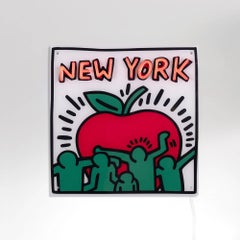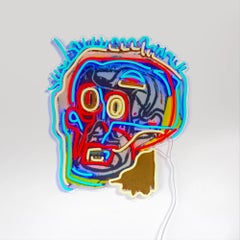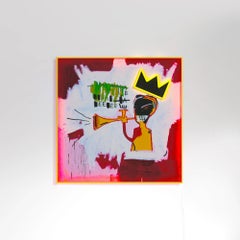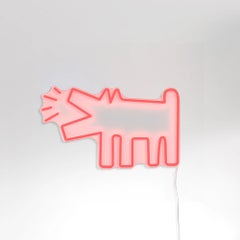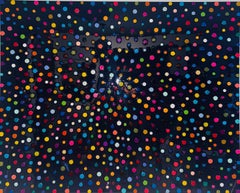Banana YP x JM Basquiat
Date of creation: 2025
Medium: PVC or Silicon piping with LED lights mounted on recycled acrylic board
Edition: Open
Size: 41 x 50 cm
Condition: Brand new
Jean-Michel Basquiat’s banana is a recurring motif in his work that, like many of his symbols, blends humor, irony, and social critique. At first glance, it may seem trivial or even comical, but within Basquiat’s visual language it takes on multiple layers of meaning.
On one hand, the banana works as a pop reference: an everyday object loaded with cultural, sexual, and even absurd connotations, echoing the tradition of pop art and artists like Andy Warhol (who, in 1967, famously turned the banana into an icon with the album cover for The Velvet Underground & Nico). Basquiat, who both admired and collaborated with Warhol, reintroduces the motif in a playful way, but with a more chaotic and visceral energy.
On the other hand, the banana can be read as a critical symbol: it connects to themes of consumerism, exoticization, and racial stereotypes. The tropical fruit evokes colonial imaginaries and the economic exploitation tied to the trade of “exotic” goods in the West. By incorporating it into his work, Basquiat decontextualizes it and turns it into an emblem full of tensions—between comedy and discomfort, pop lightness and historical memory.
Moreover, the way he depicts it —with energetic, almost childlike strokes, scattered words, and graphic marks— enhances the sense of immediacy and freshness, yet behind this apparent spontaneity lies a sharp reflection on identity, power, and contemporary visual culture.
Ultimately, Basquiat’s banana is not just a fruit: it is a visual artifact that fuses humor, irreverence, and social critique, perfectly embodying the artist’s ability to transform the everyday into a biting commentary on the modern world.
The flexible LED tube is safe and environmentally friendly, too! Set the light to the time of day with adjustable brightness.
© Estate of Jean-Michel Basquiat. Licensed by Artestar, New York.
Each sign is made of a neon flex material, consisting of PVC or Silicon piping with LED lights, that is mounted on a recycled acrylic board. These materials allow to create realistic neon signs, with bright lights and intense color, while being more durable, affordable, and sustainable than traditional neon.
Sustainability is taken seriously thanks to its LED lights which consumes 6 times less energy than traditional lights, lasting up to 100,000 hours. These neon is crafted using recycled materials and 100% recycled packaging, including removing all useless plastic.
ABOUT THE ARTIST
Jean-Michel Basquiat (1960-1988) was one of the most influential artists of the 20th century, famous for his ability to fuse urban culture, social criticism and art history into a unique style. Born in Brooklyn, New York, to a Haitian father and Puerto Rican mother, his life and work were shaped by his multicultural heritage, the New York art scene and the social tensions of his time. Although his career was brief, his impact on contemporary art has been lasting and significant.
Basquiat showed an interest in art from an early age. His mother, Matilde Andrades, took him to museums and encouraged him to draw. At the age of seven, a car accident left him hospitalized for a time, and it was then that his mother gave him a copy of the anatomy book Gray's Anatomy, which influenced his fascination with the human body and its visual representation.
Despite his early talent, Basquiat's family life was turbulent. His mother was hospitalized for psychiatric problems and his relationship with his father, Gerard Basquiat, was troubled. This instability contributed to Basquiat dropping out of school at age 17 to pursue his artistic career on the streets of New York.
As a teenager, Basquiat joined the New York graffiti scene under the pseudonym SAMO (an acronym for "Same Old Shit"), which he used to sign his cryptic and poetic messages on the streets of Manhattan with his friend Al Diaz. SAMO's graffiti were a mixture of philosophical and social commentary on popular culture, capitalism and religion, and soon attracted the attention of the underground art scene.
In 1980, SAMO "died" when Basquiat and Diaz decided to end their collaboration, marking the beginning of Basquiat's transition from street graffiti to art galleries.
Basquiat emerged as a talent to watch in 1980, when he participated in the group exhibition The Times Square Show, which included other emerging artists from New York's Lower East Side scene. That same year, he attracted the attention of critics and collectors who saw in his work an electrifying blend of street art and neo-expressionism, the predominant movement of the time.
In 1981, art critic René Ricard published the influential essay The Radiant Child in Artforum magazine, which positioned Basquiat as one of the most promising artists of his generation. Shortly thereafter, he met renowned artist Andy Warhol, with whom he formed a close friendship and significant artistic collaboration. This association was instrumental in catapulting his career into the world of high art.
The collaboration with Warhol was a pivotal point in Basquiat's career. The two artists, although coming from very different worlds, shared a fascination with fame and popular culture. Together, they produced a series of works that combined Warhol's pop art icons with Basquiat's raw, spontaneous style.
However, this collaboration was also a source of controversy. Many critics accused Warhol of "exploiting" Basquiat, while others saw the collaboration as a creative dialogue between two genius minds. Although the criticism was mixed, there is no doubt that the relationship between the two artists helped cement Basquiat's reputation in the art world.
Basquiat's style is a unique amalgam of influences. His work is characterized by the use of dismembered human figures, skeletons and internal organs, evoking the fragility of the body and mortality. Basquiat also used symbols that alluded to African-American and African history, such as crowns, masks and references to historical figures such as Toussaint Louverture.
The use of text is another crucial aspect of his work. Words, phrases and numbers appeared in his paintings, often crossed out or overlapped, creating a sense of controlled chaos. These fragmented words provoked a non-linear reading of his works and conveyed multiple layers of meaning.
His art also reflected his concerns about racial issues, especially the place of people of African descent in Western art history and in society at large. The crowns that Basquiat often drew on his figures were a symbol of power and resistance, a way of proclaiming himself "king" in a world that had historically excluded black artists from the upper echelons of art.
In works such as The Death of
Michael Stewart...
